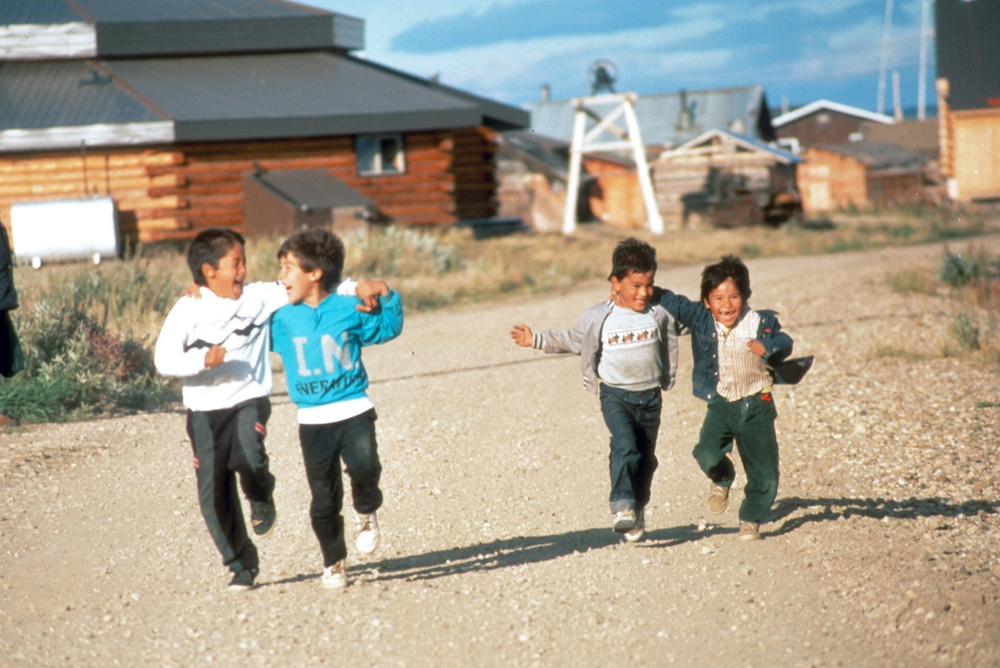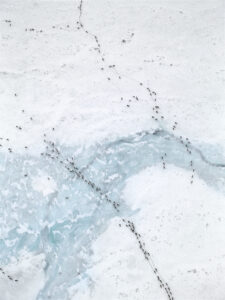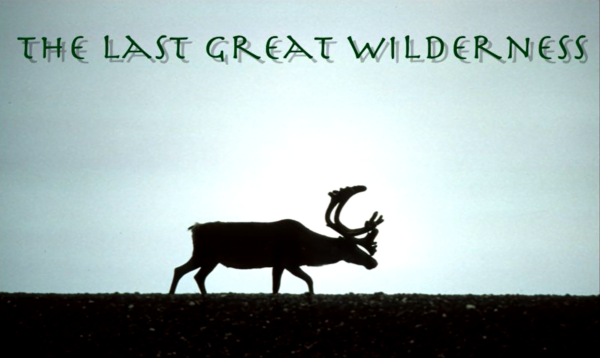
This 1987 image of four children running in Old Crow, Yukon, was one of 250 images included in “The Last Great Wilderness,” a traveling slideshow that helped keep the oil industry out of the Arctic Refuge. Left to right: Jason Benjamin, Curtis Netro, Ricky Linklater, and Phillip Bruce. Photograph by Lenny Kohm.
The story seems impossible to believe: A low-budget traveling slideshow kept oil drills out of the Arctic National Wildlife Refuge. But Indigenous leaders from the Arctic, environmental advocates on Capitol Hill, and grassroots activists across the United States all insist it’s true.
If you haven’t heard of The Last Great Wilderness, you’re not alone. During its many years on the road, the multimedia slideshow was not covered by the national media. Its photographs never became iconic. The people behind it remain unsung. And yet this humble work of activism, shared in such unassuming venues as college lecture halls, public libraries, and church basements, exerted an enormous impact on one of the biggest environmental fights in North American history. Its surprising success reminds us of the power of grassroots action to enact real change.
The Last Great Wilderness was born in response to the Ronald Reagan administration’s scheme to drill in the Arctic Refuge. Tucked away in the northeastern corner of Alaska, much of the refuge was protected as permanent wilderness in 1980, but its coastal plain was left in legislative limbo. Considered sacred by the Gwich’in Nation and called the “biological heart” of the refuge by scientists, the coastal plain provided critical, life-sustaining habitat for caribou, polar bears, and a stunning array of migratory birds. The oil industry, the state of Alaska, and powerful politicians, however, argued that the land should instead be slated for fossil fuel extraction. Congress was left to decide its fate: grant the coastal plain wilderness status or allow oil development there.

Caribou Migration I, Coleen River valley, Arctic National Wildlife Refuge, Alaska, 2002. Photograph by Subhankar Banerjee
As the debate raged, an aspiring photographer and former jazz drummer by the name of Lenny Kohm traveled in 1987 from California to Alaska, hoping to document the controversy for Audubon magazine. When Kohm arrived in the Arctic, he found himself awestruck by the spectacular wildlife he saw in the refuge and angered by the environmental devastation he witnessed in the oil fields of Prudhoe Bay. But it was the time he spent in two Gwich’in communities—Arctic Village, Alaska, and across the border, in Old Crow, Yukon—that completely changed his life. From the Gwich’in, Kohm learned that the media coverage of the refuge debate had left out a crucial part of the story. The framing was always a question of wilderness versus oil: Should the refuge’s vast coastal plain be protected as wild nature or handed over to the fossil fuel industry? This ignored what was at stake for the Gwich’in—their food security and cultural survival.
Since time immemorial, the Gwich’in people have stewarded Arctic lands and formed relations of responsibility with the caribou. Their stories, their spirituality, and their way of being in the world had always been tied to the Porcupine caribou herd. This herd, which currently numbers over 200,000 animals, journeys every year from its wintering grounds in northwestern Canada and northeastern Alaska, crossing steep mountains and icy rivers until the caribou reach the Arctic coastal plain, where they have their young. But the place where the caribou go to replenish their population was the exact place that the Reagan administration sought to turn into an oil field. This act, the Gwich’in explained to Kohm, would devastate the herd and lead to cultural genocide.
Kohm, who had never been involved in political organizing before, returned home to California and threw himself into activism, forming a small grassroots group called the Sonoma Coalition for the Arctic Refuge. The following year, he returned to Alaska. He did not come as a salvage ethnographer, seeking to create a visual record of a culture he believed was doomed to extinction. Instead, he sought to work with Gwich’in communities dotted across Alaska, the Yukon, and the Northwest Territories to bring their voices to the forefront of the refuge struggle.
The Last Great Wilderness paired almost 250 slides taken by Kohm and 15 other photographers with a soundtrack and narration, and employed what was then considered cutting-edge technology—a fade-dissolve unit—so that the slide from one projector would fade out as the slide from the next projector would fade in. For the next two decades, from 1988 to 2008, Kohm and Gwich’in representatives took their show on tour, giving as many as 200 presentations a year. Their aim was not only to educate but also to empower—to turn spectators into activists.
Every event began the same way: Kohm would turn out the lights, and as the room darkened and as the projectors began to cast images on the screen, spectators could imagine themselves embarking on a journey to a distant land. But by the end of the show, many audience members would recognize how this remote place was entangled with their own lives. They would feel a sense of obligation to the photographed subjects—and to the Gwich’in representative standing before them. They would want to join this campaign to ensure the protection of Arctic ecosystems.

The title slide from The Last Great Wilderness, with caribou image likely photographed by Lenny Kohm. Courtesy of author.
Unlike the iconic “Crying Indian” commercial and the repeated media emphasis on recycling, individual action, and green consumerism as the answer to environmental problems, The Last Great Wilderness struck a chord with audiences because it addressed them not as consumers but as citizens—and sought to enlist them in this collective project to defend the Arctic Refuge. Running contrary to its name, The Last Great Wilderness also changed conventional perceptions of wilderness. Here the Arctic was presented not as some remote, faraway place, disconnected from human society, but as land stewarded for millennia by Indigenous peoples—and still vital to their culture, spirituality, and food security. This helped audience members grasp the urgent human rights issues at stake.
The Last Great Wilderness subscribed to the “trickle-up theory of politics,” where refuge activists believed that by galvanizing citizen voices and local media coverage, their political will would “trickle up” to national media outlets and policymakers in D.C. And while there were many close calls and tense moments when it seemed that Arctic drilling proponents would prevail during the two decades that the show toured, this approach staved off development time and again, often by convincing fence-sitting politicians to vote against oil drilling. Beyond the Beltway and outside the national media spotlight, The Last Great Wilderness cultivated networks of participation and action that lasted long after the show ended. Though the slideshow alone did not save the Arctic Refuge, without the people-first political movement it built, the coastal plain’s fate would have been sealed.
In our image-saturated, social media-dominated culture, the story of an analog slideshow no doubt seems quaint, a throwback to a very different era. Yet The Last Great Wilderness was remarkably prescient in its activism, which was built upon sincere listening and learning, and sharing power and authority with Indigenous nations. Its legacy carries on through to the present, as the Gwich’in, in the face of new threats from the oil industry, continue to share their story with the public to inspire more permanent protection for the Arctic Refuge.
Take what happened in 2017, when the election of Donald Trump, together with the ongoing radicalization of the Republican Party, dealt a blow to refuge defenders, with the approval of Arctic Refuge drilling as part of the Tax Cuts and Jobs Act of 2017. Nevertheless, the first-ever oil and gas lease sale of the refuge—held on January 6, 2021, at the same time that insurrectionists were storming the Capitol—turned out to be a bust. The lackluster sale resulted, in large part, from banking and corporate campaigns led by the Gwich’in alongside Iñupiat and environmental allies who made many industry leaders decide that drilling there would be a bad investment.
The Last Great Wilderness is a reminder of how slow, patient coalition work can turn the tide by activating and informing voters and helping them realize their voices really do matter. By bringing non-iconic images and Indigenous testimony to colleges, churches, and other grassroots venues across the country, a rambling activist, Gwich’in spokespeople, and local organizers took on the power of special interests and won. In the process, they established a model for how to transform a traditional wilderness battle into something else entirely: a struggle for Indigenous rights and environmental justice.




Send A Letter To the Editors